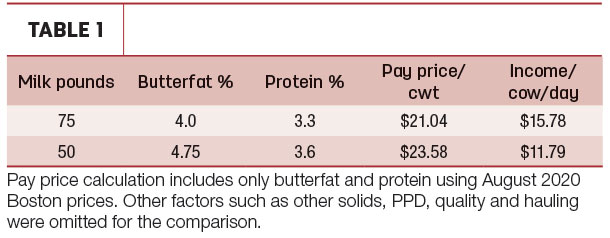Have you had to pay an overproduction penalty in the last few months? Production caps, milk quota, rolling base pounds – whatever you want to call it. Having a monthly limit on production is gaining more traction across milk processors even if the rules are not applied uniformly.
Penalties are wide-ranging – from a stern, written warning to an $8 per hundredweight (cwt) pay price for the excess milk. If you were not impacted by production limits in previous years, I bet you have had some experience with it since COVID-19 hit. The biggest hurdle for you isn’t exceeding your monthly quota; the biggest problem is not knowing how long production limits will be in place.
Some processors simply don’t exercise the deduction on months they don’t exceed supply capacity, but no one tells you that. It’s ridiculous to simply cull cows down for a few thousand pounds of milk this month only to find out you could have shipped that milk anyway.
Instead of dumping milk, culling cows or being paid pennies for something that cost dollars to produce, it’s completely possible to create a 1X-milking group. I’m not advocating for a whole herd switch, but there is a portion of your herd that could adapt to this right now, especially if you are paying an overproduction penalty. Production limits are all based on volume, but they don’t limit your component pounds. 1X-milking will reduce your volume and give you higher components. This creates an opportunity for a creative way to get under quota and still be paid for all the milk you ship by utilizing low-group-type cows.
I’m in my second year of utilizing some 1X-milking, and you can easily plan on 25% less milk with 7/10ths to a full point of additional butterfat and as much as 3/10ths to half a point of protein. That type of component increase helps offset the decrease in volume so you can keep your cows and your cash flowing. As Table 1 shows, there is a decrease of total income per cow per day, but this does offer a way to cover feed and maintenance costs and decrease overproduction penalties, which is the real goal here. Drying cows off, culling cows, dumping milk or paying overproduction penalties won’t cover any fixed costs either, but a 1X-milking group can help. Don’t write off the lower income per cow on the surface; this is simply a tool to manage a problem that will pay higher than the alternatives.

Table 1 reflects normal circumstances switching a 75-pound cow to 1X-milking with all milk being shipped for the same price. If you are one of those farms being paid $8 per cwt for overbase production, then your income per cow is closer to $5 per day than $15. There is some value to getting a few more pounds of components if you are currently over your production limit.
Most of the research that is available with 1X-milking is from grazing herds as a way to handle low production when grass starts getting scarce, either from drought or late-season availability. Most published papers that you can find will show results right in the same neighborhood that we see here. Anything from 20% to 30% reduction in volume with a half to full point increase of components and an increase in body condition. There’s also the added benefit of only handling these cows once instead of two to three times per day.
If you are going to create a 1X-milking group, look for those cows that are 100-120 days carried calf and giving less than 75 pounds of milk. 1X-milking will decrease a 120-pound cow by 50%, but a 75-pound cow can still give 50 pounds or more on 1X-milking. A cow three to four months pregnant is an excellent place to start because you already have taken her past peak milk, and you are only going to have her milking another 100 days until dry-off; it’s a low risk cow to start with. I would also favor any pregnant cow under a 3.0 body score, as 1X-milking will shape that cow up in a hurry. This also gives you an opportunity to put this group as far away from the parlor as possible and let higher-producing cows have the shorter commute to the parlor.
If you have never heard of 1X-milking, it’s tough to wrap your head around. You won’t need any feed changes to get the extra pounds of components. Most people think cows will explode, get mastitis or die. Certainly those things can happen, and you will find 1%-2% of cows will not adapt. The first week of this program will most likely elevate your cell count by 100,000, but that will settle back down quickly to your normal range in a few days. Keep in mind: At one time or another, 3X-milking, calf hutches and freestalls were all considered crazy too.
Other instances where 1X-milking offers some consideration are maxed-out parlors and lame cows. Dairies that walk cows long distances with slope and sandlike flush barn situations can be hard on feet. Cows that can’t adapt to those conditions but are otherwise functional, productive animals could be grouped together and milked one time. Parlors that shut down only once per day to wash or are constantly running behind should consider a 1X-milking group to build some more wiggle room into the daily schedule.
I am not advocating for a whole herd switch to 1X-milking. But as a grouping strategy to target a specific problem in thin cows, thin soles or individual farm overproduction limits, this is an excellent opportunity. If you have specific 1X-milking questions, I would be happy to answer those at my blog, Dairyhack.




